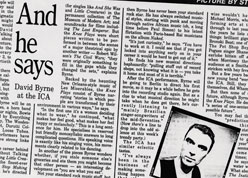ORIGINAL
PRESS CLIPPINGS

KNEE PLAYS FIRST BEND THE MIND,
Then Leaves a lot to the Imagination
"the Knee Plays," at the Civic Theatre through May 29, is our first view in Chicago of the theatrical poetry of Robert Wilson, and at first it seems that we may simply be getting a look at the emperor's new clothes.
What's going on here? The house lights dim, a narrator and the seven musicians of the Les Misérables Brass Band, all clad in solid black, file solemnly from the wings and descend from the stage to their music stands, set up in front of a plain Japanese screen. The tuba and trombone begin a series of mournful sighs (composed by David Byrne), while a woman in a brown kimono (choreographer Suzushi Hanayagi on Tuesday's opening night, representing a lion) comes out to hop about very deliberately around a T-square tree built of 32 interlocking white cubes. The narrator begins, in Byrne's text: "This is an important occasion."
Wilson, as this opening scene so amply demonstrates, is not a teller of linear stories. Rather, he combines music, language, film, props, slide projections, puppets, masks and a corps of 10 dancers dressed in pure white to create a spark for the viewer's imagination. Their meanings are not always clear at the moment, but patience in observing and absorbing them is rewarded. Like elements of a poem that collectively engender emotion, the parts of his "opera" add up and come full circle in their meaning.
A little knowledge of Wilson's unique and startling work in contemporary theater is helpful, and the program for this International Theatre Festival presentation includes Byrne's text, Wilson's diagrams and informative notes on the history, music, movement and sets of "the Knee Plays." The piece, lasting about 110 minutes without intermission, was developed in workshops just before its Minneapolis premiere in 1984, and originally was conceived as a related series of 13 entr'actes to be used in Wilson's massive, unfulfilled, 12-hour, 15-scene magnum opus for the 1984 Olympic Arts Festival in Los Angeles, "the CIVIL warS: a tree is best measured when it is down." (Wilson apparently likes to bend our vision of things even in the way he uses capitalization.)